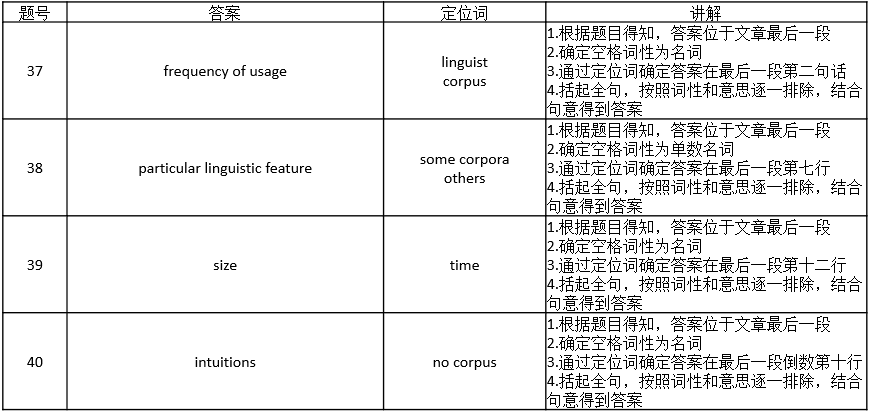雅思阅读14类题型解题技巧之选择题
俗话说“磨刀不误砍柴工”~弄清楚雅思阅读常见的14类题型及其相应的答题技巧,下面小编给大家带来了雅思阅读14类题型解题技巧之Multiple Choice(选择题),下面小编就和大家分享,来欣赏一下吧。
雅思阅读14类题型解题技巧--Multiple Choice(选择题)
Multiple Choice(选择题)
1. 题型要求
这是一个传统题型,大家都很熟悉。但就是这种大家都熟悉的题型,IELTS考试也要弄出新花样:四选一和多选多两种。
四选一,选项肯定是四个。即要求从A、B、C、D四项中选择一个最符合题意的选项。
多选多,选项肯定是五个或五个以上,而正确答案的数目肯定在两个以上。
哪个更难呢?很多同学会好不犹豫地说是多选多。实际上,多选多很容易,是一种简单题型。它具有以下几个特点:
(1) 正确答案的数目是已知的。在题目的要求中会告诉你要选出几个选项。题目要求中常WHICH FOUR, WHICH THREE 等字样。
(2) 答案在原文中是集中出现的,对应原文中的例举。找着一个答案,其余几个就在它的前后不远处。
我们举一个中文阅读的例子来说明。文章如下:
帕金森症是一种顽症。它是由大脑中缺乏一种叫多巴胺的化学物质引起的。(后面删减100字)很多名人深受其苦。比如,我们的改革的总设计师邓小平、拳王阿里、以故数学家陈景润等等。(后面删减100字)
题目是:以下哪三个人得过帕金森症?
A. 邓小平
B. 里根
C. 拳王阿里
D. 布什
E. 陈景润 答案:ACE
四选一在考试中,一般比较难。它的特点是:四个选项,哪个都像。好像在原文中都提到了,但又都和原文的叙述不太一样。很容易选错。
选择题和问答题的区别在于:问答题要求你自己从原文中找答案。而选择题给你四个选项,让你选择,在给你提示的同时,也给了你一个陷阱。有些选择题,如果改为回答题,你可能能够做对,但给了你四个选项,反而选错了。
考试中,四选一,A类和G类一般都是每次必考,考一组,共3题左右。多选多,不是每次必考。
2. 解题步骤
(1) 找出题干中的关键词,最好先定位到原文中的一个段落。
将题干中的关键词与原文各段落的小标题或每段话的第一句相对照。有些题目能先定位到原文中的一个段落,着必将大大加快解题时间,并提高准确率。但并不是每个题目都能先定位到原文中的一个段落的。
如果题目中的关键词难以确定答案的位置,选项中的关键词也可以作为定位的参考依据。
(2) 从头到尾快速阅读该段落,根据题干中的其他关键词及选项确定正确答案。正确选项常常是原文相关词句的改写。
确定一个段落后,答案在该段落中有的具体位置是未知的。所以,需要从头到尾快速阅读该段落,确定正确答案。短问答的答案常常是原文原词,而选择题的答案常常是原文相关词句的改写。
(3) 有些题目比较简单,可以直接选择。对于难题,可以用排除法确定正确答案。
有些题目比较简单,从原文很快找到对应答案。这时可以直接选择不必看其它选项。既可以节省时间,同时也避免受干扰选项的误导。
有些题目比较难,看每个选项都有点像,但又都不太象。这时,可以用排除法,先排除掉肯定不对的选项,然后在剩下的选项中再做出选择。通常,有两个选项必有好排除,另外两个有一定的难度。请参见本题型的注意事项部分,其中分析了干扰选项的特点。
(4) 要注意顺序性,即题目的顺序和原文的顺序基本一致。
题目是有顺序性的。第一题的答案应在文章的前部,第二题的答案应在第一题的答案之后。这个规律也有助于同学们确定答案的位置。
NOTICE:
1. 如果一个选项合乎题意,还要看其它选项中是否有both…and、all of the above的字样。
我们举一个中文阅读的例子:
原文:如果你随便停车,要罚你款,还要把你的车拖走。
题目:如果你随便停车,将:
A. 被罚款
B. 你的车被拖走
C. 没事儿
D. both被罚款and你的车被拖走 答案:D
如果选项中有一个是all of the above,它是正确选项的可能性很大。Both…and是正确选项比all of the above小一些。总之,如果一个选项合乎题意,不要马上选。看一眼其余选项中是否有both…and, all of the above的字样。
2. 注意题干中是否有not, except的字样。
题干中有这些词时,通常是将它们大写并使用黑体,特别醒目。如果不注意看,必然答错题。
如前面的关于帕金森症的中文阅读文章,可能出一道四选一的题目:
题目:下面的人得过帕金森症EXCEPT
A. 邓小平
B. 里根
C. 拳王阿里
D. 陈景润 答案:B
3. 干扰选项的特点
做选择题的过程就是与干扰选项做斗争的过程。清楚干扰选项的特点,就能做到百战百胜。干扰选项特征如下:
A. 无:选项中所讲的内容在原文中根本不存在,或找不到语言依据。要注意,答题的唯一依据是原文,不能凭借自己的知识或主观想象。
B. 反:与原文相矛盾的选项。这时要注意题干或原文中是否有NOT、EXECPT等词,也要注意反义词。
C. 满:含有“绝对意义”的词汇如must、always、all、will的选项,一般为错误选项。选项中含有“相对意义”的词汇如can、may、sometimes、some、not always,一般为正确答案。也就是说,越是模棱两可、含含糊糊,越可能是正确答案,因为它适用的范围更广。这条规律的适用性很强,实践证明它的准确率在90%以上。
D. 偏:似是而非,与原句部分相似的选项。这是不太容易排除的。
E. 混:张冠李戴,有时题干是主语,选项是谓语,要留心题干的主语和选项的谓语构成的主谓结构是否张冠李戴。这种干扰项规律也比较明显,常常是这样的:
原文:甲事物的特征是X。乙事物的特征是Y。
题干是甲事物,选项中肯定有特征Y,但肯定没有特征X。为什么呢?特征Y就是让你选的干扰项,如果选项中有特征X,你肯定会选它,就不会选错了。也就是出题者为了这个精心布置的陷阱成功,他会舍弃特征X,而在文章的其它地方谈到甲事物的时候,出现一个正确答案。
4. 正确选项应是原文的改写,与原文特别一致的选项应引起怀疑。
正确选项应是原文相关词句的改写,所以与原文特别一致的选项是正确选项的可能性不大。
雅思阅读摘要题讲解--Obtaining Linguistic Data
Obtaining Linguistic Data
A
Many procedures are available for obtaining data about a language. They range from a carefully planned, intensive field investigation in a foreign country to a casual introspection about one's mother tongue carried out in an armchair at home.
B
In all cases, someone has to act as a source of language data — an informant. Informants are (ideally) native speakers of a language, who provide utterances for analysis and other kinds of information about the language (e.g. translations, comments about correctness, or judgments on usage). Often, when studying their mother tongue, linguists act as their own informants, judging the ambiguity, acceptability, or other properties of utterances against their own intuitions. The convenience of this approach makes it widely used, and it is considered the norm in the generative approach to linguistics. But a linguist’s personal judgments are often uncertain, or disagree with the judgments of other linguists, at which point recourse is needed to more objective methods of enquiry, using non-linguists as informants. The latter procedure is unavoidable when working on foreign languages, or child speech.
C
Many factors must be considered when selecting informants — whether one is working with single speakers (a common situation when languages have not been described before), two people interacting, small groups or large-scale samples. Age, sex, social background and other aspects of identity are important, as these factors are known to influence the kind of language used. The topic of conversation and the characteristics of the social setting (e.g. the level of formality) are also highly relevant, as are the personal qualities of the informants (e.g. their fluency and consistency). For larger studies, scrupulous attention has been paid to the sampling theory employed, and in all cases, decisions have to be made about the best investigative techniques to use.
D
Today, researchers often tape-record informants. This enables the linguist’s claims about the language to be checked, and provides a way of making those claims more accurate (‘difficult’pieces of speech can be listened to repeatedly). But obtaining naturalistic, good-quality data is never easy. People talk abnormally when they know they are being recorded, and sound quality can be poor. A variety of tape-recording procedures have thus been devised to minimize the ‘observer’s paradox’ (how to observe the way people behave when they are not being observed). Some recordings are made without the speakers being aware of the fact — a procedure that obtains very natural data, though ethical objections must be anticipated. Alternatively, attempts can be made to make the speaker forget about the recording, such as keeping the tape recorder out of sight, or using radio microphones. A useful technique is to introduce a topic that quickly involves the speaker, and stimulates a natural language style (e.g. asking older informants about how times have changed in their locality).
E
An audio tape recording does not solve all the linguist’s problems, however. Speech is often unclear and ambiguous. Where possible, therefore, the recording has to be supplemented by the observer’s written comments on the non-verbal behavior of the participants, and about the context in general. A facial expression, for example, can dramatically alter the meaning of what is-said. Video recordings avoid these problems to a large extent, but even they have limitations (the camera cannot be everywhere), and transcriptions always benefit from any additional commentary provided by an observer.
F Linguists also make great use of structured sessions, in which they systematically ask
their informants for utterances that describe certain actions, objects or behavior. With a bilingual informant, or through use of an interpreter, it is possible to use translation techniques (‘How do you say table in your language?’). A large number of points can be covered in a short time, using interview worksheets and questionnaires. Often, the researcher wishes to obtain information about just a single variable, in which case a restricted set of questions may be used: a particular feature of pronunciation, for example, can be elicited by asking the informant to say a restricted set of words. There are also several direct methods of elicitation, such as asking informants to fill in the blanks in a substitution frame (e.g. I ___ see a car), or feeding them the wrong stimulus for correction (‘Is it possible to say I no can see?’).
G A representative sample of language, compiled for the purpose of linguistic analysis,
is known as a corpus. A corpus enables the linguist to make unbiased statements about frequency of usage, and it provides accessible data for the use of different researchers. Its range and size are variable. Some corpora attempt to cover the language as a whole, taking extracts from many kinds of text; others are extremely selective, providing a collection of material that deals only with a particular linguistic feature. The size of the corpus depends on practical factors, such as the time available to collect, process and store the data: it can take up to several hours to provide an accurate transcription of a few minutes of speech. Sometimes a small sample of data will be enough to decide a linguistic hypothesis; by contrast, corpora in major research projects can total millions of words. An important principle is that all corpora, whatever their size, are inevitably limited in their coverage, and always need to be supplemented by data derived from the intuitions of native speakers of the language, through either introspection or experimentation.
真题讲解:


长难句练习:
1. But a linguist’s personal judgements are often uncertain, or disagree with the judgements of other linguists, at which point resource is needed to more object methods of enquiry (询问), using non-linguists as informants.
参考译文:然而,一名语言学家的个人判断通常是不确定的,或者是与其他的语言学家意见不同,此时,就需要更加客观的询问方式,让非语言学家来充当资料提供者。
语法点:point的用法:at the point of正在……的时候; come to the point 谈到正题;have one’s point 有独到之处;up to point在一定程度,有一点
2. Video recordings avoid these problems to a large extent, but even they have limitations (the camera cannot be everywhere), and transcription always benefits from any additional commentary provided by an observer.
参考译文:录像方式在很大程度上可以避免这样的问题,但是就算是这个方式也存在局限性(摄像机不可能安得到处都是),而且文字誊本总是要得益于观察者另外提供的注解。
语言点:benefit的用法:益处、好处;义演、义卖
3. An important principle is that all corpora, whatever their size, are inevitably limited in their coverage, and always need to be supplemented by data derived from the intuitions of native speakers of the language, though either introspection or experimentation.
参考译文:一个重要的原则是,无论大小,所有的语料库在覆盖面上都不可避免的存在局限性,因此,他们就总是需要通过内省或实验的方式,被源自母语者的直觉的资料补充。
语言点:principle是主语,is是系动词,that引导表语从句,whatever their size是插入语。表语从句的主语是all corpora;谓语是are limited,need to be supplemented;derived是过去分词作定语来修饰data; through引导的是状语。
雅思阅读14类题型解题技巧之选择题相关文章:
★ 雅思写作满分的3点经验分享
★ 雅思阅读技巧之顺序原则
★ 雅思听力配对题解题方法详述
★ 雅思听力考试内容介绍





